I began family history research in the late 1990s and since then I have enjoyed discovering the stories of the lives, loves, tragedies and challenges that faced my ancestors. We all get something different from this incredibly rewarding and yet frustrating pursuit. Some family historians focus on identifying the names and key dates of their ancestors. They aim to get as far back in time as possible. Others study a specific family line, often the paternal-surname line. For others, it is to get as many people on their family tree as they can. The number of people I have seen on some online family trees is staggering. How anyone can manage a Family Tree of 30,000 plus people is beyond me, never mind some who have over a million!! However, everyone to their own.
For me, I love learning not just my ancestor’s names and their key life dates but also the society they lived in. What kind of lives did they have? Were they rich or poor? What were their beliefs? What was the economic and social context in which they lived?
My family history tree has, on my paternal, side the Lawrie-Bruce lines who came from the North East of Scotland. That side were fixtures in Aberdeenshire and Kincardineshire from the earliest records until my grandparents escaped to Fife in the early 1950s for work purposes. My maternal Smith-Lindsay family lines were from Stirlingshire and Lanarkshire together with the usual splattering of Irish ancestry. Both lines have an occasional touch of highlander blood reflecting emigration from the North-West of Scotland. The makeup of a very typical Scottish family history.
I have enjoyed learning the trials and tribulations of my ancestors who toiled as farmworkers, stonemasons, iron moulders and coal miners. I am proud that they were ordinary working-class people trying to make the best they could from a system and a society where opportunity was very much weighted against them.
I have had no desire to find any trace of royalty or landed gentry in my family tree. I am not a royalist and believe that deciding a nation’s Head of State based solely on the family a person was born into is something that should be consigned to history. It is not to say that I don’t enjoy reading about the fascinating history of royalty and nobility and their place in Scotland’s history. The only benefit I could see in tracing a noble or royal line in my humble family tree would be to enjoy a different genealogy experience to me, one that would allow me to search a different set of records than those used to research my working-class ancestors and allow me to go beyond the usual 1600/1700 timeframe.
I always treat with suspicion someone who claims to be a direct descendant of Robert the Bruce or some other name from history. We know that if we all could go back far enough in the records it is likely that somewhere in our thousands of ancestors, we will all be related to someone in royalty. Proving it with proper sources and evidence is a different matter.
Today online family trees are full of so many errors with little or no sources. With a couple of clicks of a button these errors are then duplicated into other people’s family trees. I have seen a number in my own family with outrageous claims of lineage that have no basis in fact and with the merest analysis could be proven to be incorrect. This approach gives rise to false claims as people seek their “celebrity” ancestor usually in the form of royalty or nobility.
It is my view that many online trees are too far gone to be fixed. For that reason, I only use the hints and tips in online family trees as clues for my research. I never accept hints or download branches direct from someone else’s online family tree. It may take more time to input and mean that my Lawrie-Bruce tree has only 1600 people on it but I know it was me that added them and it is my rationale and justification for each person and branch added.
FINDING MY STUART LINE
Despite the enjoyment I got from my family history research I had one glaring frustration – finding my Stuart line. For several years this was a major gap in my family tree. It was my YDNA line – the very top line of my Pedigree Chart. It was the genealogical equivalent of missing two front teeth – a huge obvious gap glaring out from every pedigree chart or report I printed.
My grandad was born in Aberdeen in 1914. He was born out of wedlock and had no contact with his biological father. Thankfully my great granny took his father to court in October 1914 and successfully proved paternity. From the Register of Recorded Entry attached to his birth record in Scotlandspeople we know his father’s name and the address in Aberdeen he lived in 1914.
In time and with the release of the 1911 Scotland Census I was able to make the necessary breakthrough and positively identified my great grandfather’s Stuart line. The family came from Aberdeen where they worked as Carters and were involved in the granite industry. The line went back to the parish of Fyvie, north of Aberdeen where my 2 x great grandfather was born in 1862. He was named James Stuart born, again out of wedlock which was common in Aberdeenshire and will be a consistent thread as this story develops.
James was born at Burnside of Meadaple in Fyvie to another James Stuart and a local girl Ann Reid. James was living and working with his older sister and her family at Meadaple with Ann also living close by with her widowed mother at Meadaple. The two were never married but James admitted his responsibility and both James and Ann were present when the birth of their son was registered in Fyvie in1862. There remained a question mark for some years on whether I had the right James Stuart although there were no others in the area. Thankfully subsequent DNA matches have confirmed my earlier research. A good example of how DNA can help confirm your family history research.

Birth Record – James Stuart. 1862. Fyvie, Aberdeenshire. 197/00. 044. 130. Reproduced courtesy of National Records of Scotland
The couple never married and the father James Stuart later left Aberdeenshire and moved to Edinburgh where he married a girl who was also from Aberdeenshire. He worked briefly as a Police Officer in Edinburgh, and later working as a warehouseman. He died in 1885 aged only 44 years old with four young children to his wife (Deaths (CR). St George, Edinburgh. 1885. 685/01. 0569).
Despite these numerous challenges, good progress was made in my research. The records showed that the James Stuart who died in Edinburgh was born in Forgue, Aberdeenshire in 1841 to his father James Stuart, an agricultural labourer and his wife Christian Duncan. This James Stuart, my 4 x great grandfather died in Forgue in 1857[1]and is buried in the local Kirkyard.
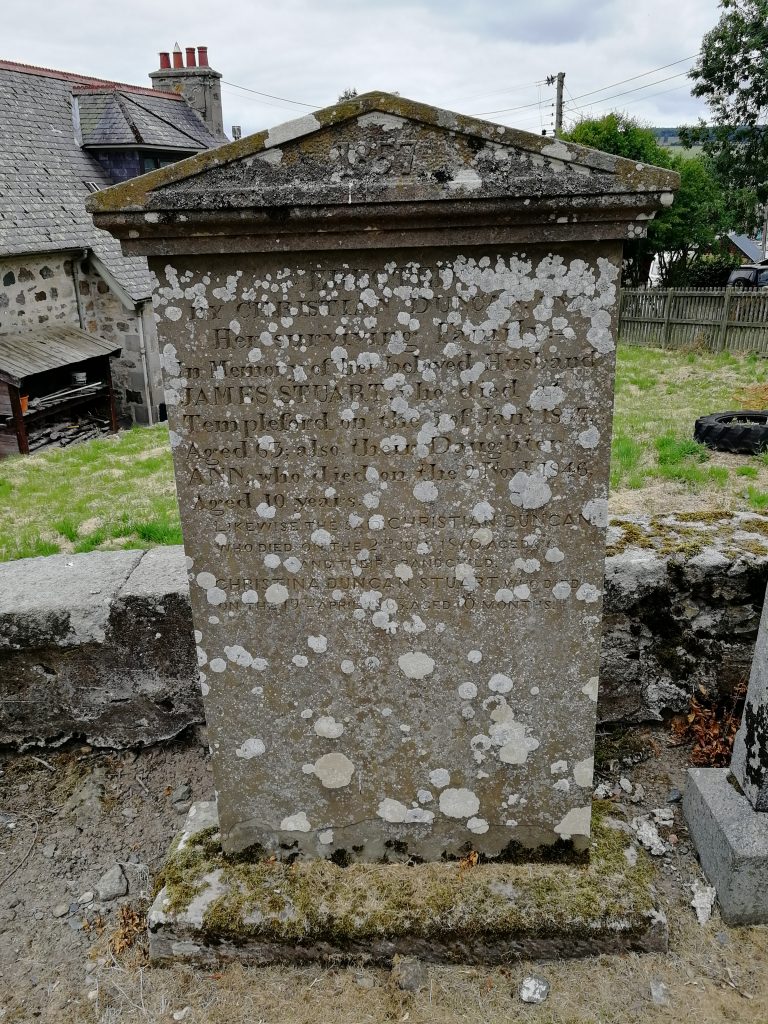
Headstone – JAMES STUART & CHRISTIAN DUNCAN. Forgue, Aberdeenshire. Photograph by Gary Lawrie.
One thing I have learned over the years is that whilst there are so many genealogical skills that can be learned often it is not just the knowledge or ability of the researcher but the luck of where and when death, birth or marriage lands. It was lucky for me that James Stuart held on to die after 1855 and the beginning of statutory registration in Scotland. I traced his death record which is shown below.
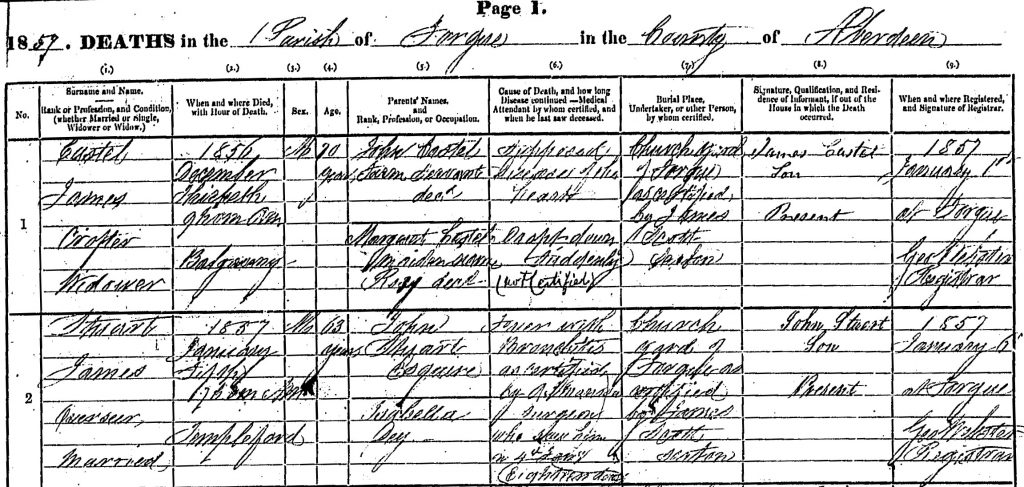
Death Record – JAMES STUART – 1857. Forgue, Aberdeenshire. 194/00. 002. Reproduced courtesy of National Records of Scotland
A pretty run of the mill Death Record you would say. There were two things I noted besides the name of James’s parents which were given as John Stuart and Isabel Dey. One was that they did not appear to be married. We know that Registrars had to follow certain rules on what to record which changed over time. However, we have to remember that they were human and some were more detailed and consistent in what they recorded than others. It is therefore often worth checking the adjoining entries to see if there is a pattern to how rigorous the Registrar was on their work or otherwise. In this record the adjacent deaths recorded both the married and maiden name of the deceased’s mother. Isabel Dey was recorded as only Isobel Dey with no indication of them being married. From this, it can be inferred that Isobel and John Stuart were never married and James was born illegitimate. This was reinforced by the absence of any marriage record between them in any Old Parish Record.

James Stuart “Esquire” – 1857. As above. Reproduced by courtesy of National Records of Scotland
However, of greater interest was that John Stuart was recorded as “John Stuart Esq” as shown above. Esq stands for Esquire which was used to indicate a gentleman or person of nobility[2] and in some instances was used to indicate a lawyer. So it looked like my 5 x great grandfather John Stuart could break my run of good old working-class ancestors.
Tracing the right John Stuart in this area was a challenge as there were many Stuart landholding families in the area around Forgue and adjoining parishes. The 1851 Census told me that my James Stuart was born in Botriphnie just over the border in Banffshire around 1793. The OPR Birth/Baptism record listed the briefest of details of his baptism and parents names and provided no further way forward.
However, a check of the Kirk Session records for Keith[3], held in The National Records of Scotland found that my 5 x great grandfather had been summoned in front of the Session to answer for his sin and fornication with Isobel Dey. He was styled “Young Birkenburn” and his admission coupled with a timely donation to the Poor Fund in the Parish by his father helped smooth the way. Proof, as if we needed it, that those in power and influence have been acting in this way for centuries!!
The Kirk Session records have begun to appear on the Scotlandspeople website and are a wonderfully useful resource as I found in this instance. The records are not indexed but can provide far more detail about your ancestors than is found in the Old Parish Records.
This John Stuart, styled “Young Birkenburn” in 1793, died in 1844 in Keith, Banffshire. He never married. I traced his Will on the Scotlandspeople website and I doubt there will be many better scripted Wills that would help proves the lineage for an illegitimate child.
In his Will, written in 1842, John Stuart Esquire states[4]“to make payment to my reputed son, James Stuart, presently servant at Auchaber in the Parish of Forgue the sum of Five Hundred Pounds Sterling….and to deliver to him within the same period all my shirts and other wearing apparel.”
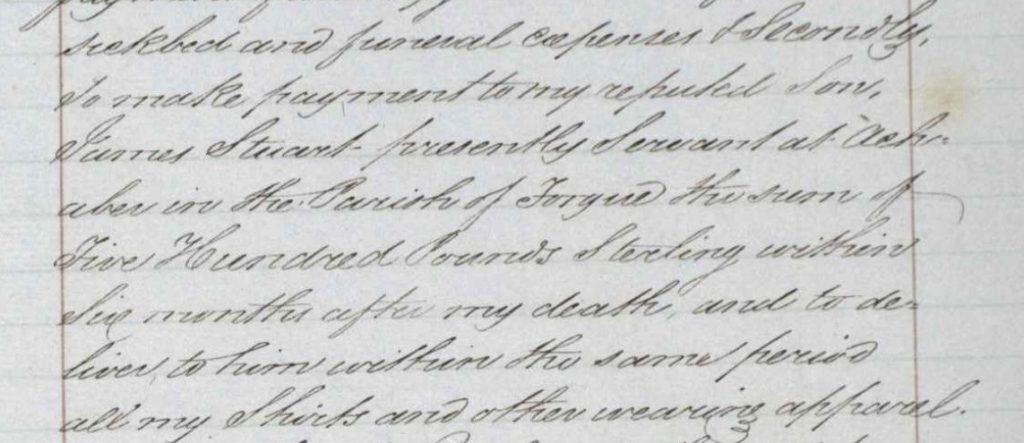
Testamentary Records – John Stuart, Formerly IX Laird of Birkenburn. SC2/40.10. Reproduced courtesy of National Records of Scotland
In the 1841 Census[5] my 4 x great grandfather James Stuart was living and working at Auchaber, Forgue as a farm labourer with no other similarly named person in the area or adjoining parishes. This, together with the Death, Census and Kirk Session records provide compelling proof that this was James Stuart’s father and thus my Stuart family line. Subsequent testing of my YDNA again confirmed my lineage to be Stuarts.
So it turns out that I am a direct descendant of the Stuarts of Birkenburn. John Stuart, the 9th and what I later discovered, the final Laird of Birkenburn in Banffshire is my 5 x great-grandfather.
So who was this John Stuart? and what or where was Birkenburn?
Birkenburn was a notable house and estate in Keith, Banffshire and historically a minor house of the Gordon family dating back to the 1500s and linked to the Gordon of Lesmoir and the Earl of Huntly. The house moved from the Gordons to the Stuarts in the 18th Century when the male line died out. It had disappeared by the time the Ordnance Survey began producing its maps but does feature in earlier maps including the map below by Aaron Arrowsmith from 1807, located a few miles south-east of Keith.
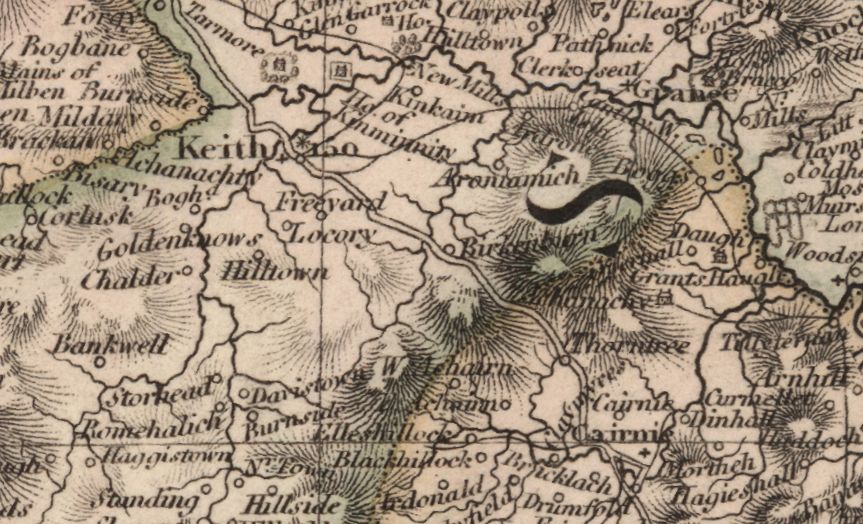
Birkenburn nr Keith, Banffshire. Aaron Arrowsmith. 1807. Reproduced courtesy by National Library of Scotland
The history of the family appears in many notable genealogy publications of the time and opened up a new opportunity for my research. My findings found a family whose history and links extend into many of the notable families and historical events in Scotland. A 19th century local history book of the town of Keith makes a tantalising claim of the Birkenburn Gordons being related to royalty in both Scotland and England. A challenge no genealogist could possibly refuse!!
The background and history of Birkenburn will feature in the 2nd part of this blog with the story of many of the noted family members featuring in future additions. In the meantime the chart below gives a summary of my lineage from myself back to my 5 x great grandfather John Stuart, the Ninth Laird of Birkenburn.
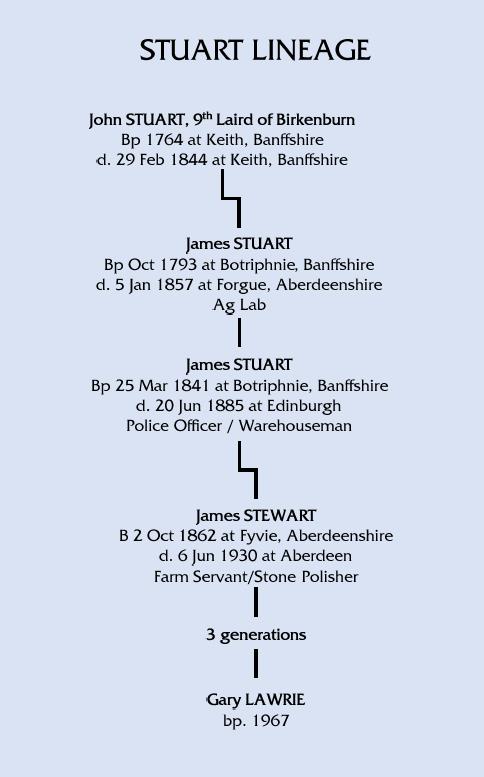
[1] Deaths (CR) Scotland. Forgue, Aberdeen. 1857. STUART, James. 194/00. 002. Http://www.scotlandspeople.gov.uk
[2] Durie, Bruce. 2013. Understanding Documents for Genealogy & Local History. The History Press. Stroud, Gloucestershire. p301.
[3] Kirk Session Records. Scotland. Keith, Banffshire. 22 Nov 1793. CH2/570/5/41. Collection: The National Records of Scotland, Edinburgh
[4] Testamentary Records. Scotland. 4 April 1844. STUART, John. Trust Disposition and Settlement. Banff Sheriff Court. SC2/40/10. http://www.scotlandspeople.gov.uk
[5] Census 1841 Scotland. Forgue, Aberdeen. STUART James, Auchaber. 194/00. Collection: The National Records of Scotland. Http://www.scotlandspeople.gov.uk
Fascinating story and well researched. Thanks for sharing.
Thank you for the feedback Mark.
Have an illegimate grandfather and suspect similar situation. His mother and grandfather worked on a farm where the unmarried owner left all his clothes and 100 guineas to the grandfather. According to family stories it seems suspicious that owners cousin took grandfather fishing and shooting with him as a child afterwards, then left all his guns to grandfather on his death they were not listed in his will though. He only had daughters. Cant prove anything though
Hi Peter. Thanks for the feedback and illegitimacy was very common in the NE of Scotland. I understand that it had the highest or one of the highest rates of illegitimate births for a period of time. I think the circumstances in which people lived ie bothy, chaumer and young single girls leaving home and staying away would all have contributed to what must have been a tough life. I know many people have stories of ancestors becoming pregnant to the laird and generally speaking they are often proven to just be a tale. However it looks like this was the case for me and indeed may have been for you. It is rare to get a will as explicit as my one from John Stuart and my jaw nearly hit the floor when I read it first. It could not be more clear!!
Thanks once again for the comment.
Well written and very interesting! My ancestors on my Mother’s side come from the same area near Keith. Although, I was born in Manitoba I moved to Scotland at the age of four to a farm outside Keith, in Cairnie. I know the names of those farms you showed on the map.I returned to Canada 1953 and have lived in Nova Scotia, ever since. I don’t have any relatives that are related to the Stuarts. Happy searching